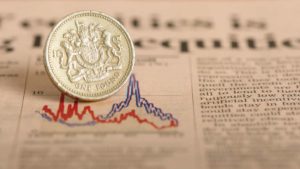Barclays’ (LSE: BARC) share price has risen 77% from its 30 October 12-month low of £1.28. However, this does not mean there is no value left in stock.
It could be that the market has just been catching up with the true worth of the shares. And it may be that the stock’s price still does not reflect its fair value.
How much room for further gains?
On the key price-to-book (P/B) ratio measure of stock valuation, Barclays trades at 0.5. This is cheap compared to the average 0.7 P/B of its competitors.
This group comprises Standard Chartered (also at 0.5), NatWest at 0.7, and both HSBC and Lloyds at 0.8.
The same relative undervaluation for Barclays is also seen in its price-to-sales ratio of 1.4. This compares to a peer group average of 2.
To ascertain how much scope there is for further share price gains I used a discounted cash flow analysis. This shows the stock to be 26% undervalued at its present price of £2.26.
Therefore, a fair value for the shares would be £3.05. They may go lower or higher than that, but it underlines how much value is left in them.
The bank’s new vision
Barclays’ price rise since October was primarily driven by its new strategy to be a ‘Simpler, Better and More balanced’ business, in my view.
This involves selling off non-priority businesses (including its German consumer finance operation) and building up its Corporate and Investment Banking franchise.
It announced the sale of this German business on 4 July. And it was reported on 10 July that it plans to quadruple its private banking assets in Asia by end-2028.
This vision is aimed at achieving a return on tangible equity (RoTE) of 10%+ this year, and 12%+ in 2026. It also includes dispersing £10bn+ to shareholders over 2024-26 through dividends and share buybacks. Both these rewards tend to be supportive of share price rises over the long term.
In its full-year 2023 results, it achieved a RoTE of 10.6% and total share buybacks of £1.75bn. It also raised its annual dividend from 7.25p to 8p and announced a new share buyback of up to £1bn.
Analysts’ estimates are that Barclays’ earnings will grow by 11.9% each year to end-2026. Earnings per share are forecast to rise by 16.4% a year to that point.
Time for me to buy the shares?
So far, so good, it seems to me, on the implementation of Barclays’ new vision. However, there are risks in the shares, as in all stocks.
A major slip-up in any of the multiple moving parts in its reorganisation could prove very costly. Additionally, its ongoing UK retail banking business faces declining margins as interest rates fall along with inflation.
That said, neither of these factors bothers me enough not to buy the shares.
Both the Indian and Singaporean economies (the focus of Barclays’ Asia expansion) continue to grow strongly. And inflation and interest rates are cyclical – they will no doubt rise and then fall many times from here.
If I did not already own shares in two banks (HSBC and NatWest), I would buy Barclays’ stock today. There looks a lot of value left in it, and I feel further gains are likely based on the bank’s strong growth prospects.
This post was originally published on Motley Fool







